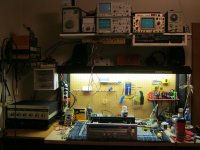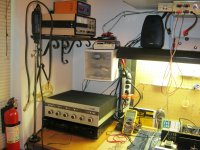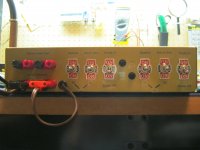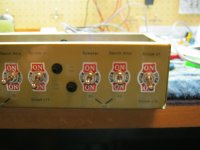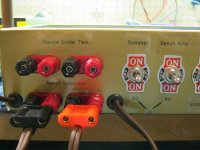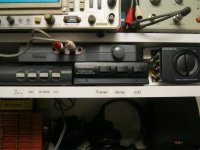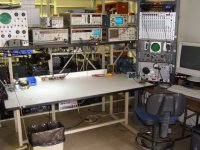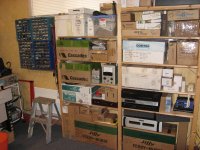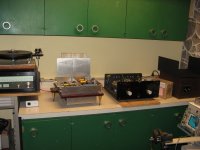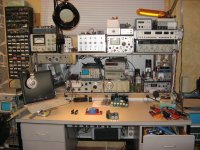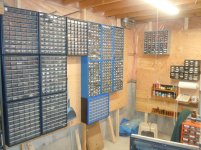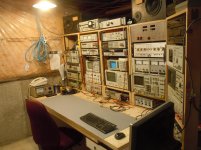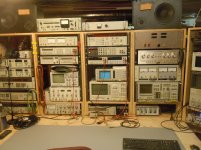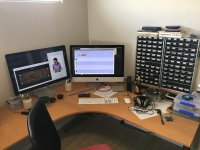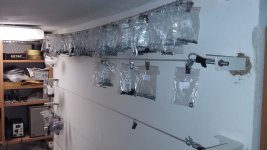Mine used to short the high voltage filter capacitor until I put in an overrated one. The the power transformer developed a short from the CRT filament supply. After one transformerectomy the second time I used a flat pack transformer as a 1/1 isolation transformer. Use a 6 or 12 volt unit one secondary winding in the other out and leave the primaries open. I put it in a small plastic box on the back of the unit. After that the only issue was it's DC drift.
Mine shorted the transformer early on; Heath replaced it under warranty. No major failures since, although I've worried about unreplaceable parts like the transformer. I still use it because it works and fits in the available space, so the HP 'scope only gets hauled out once in a while! I replaced an input JFET on one of the preamps, which fixed a serious linearity problem; the other channel isn't quite so bad but I haven't figured it out yet.
Now working on a rebuild of a Son of Ampzilla; sounds pretty darn good so far.
I've been promised a broken Hafler DH220 as my next challenge!
Last edited:
I just started collecting stuff for the bench, I have just started to learn how to use some of this equipment. (2 months now) I have a teacher that has been very good to me and has helped me design a very nice bench with all pieces linking together through a panel box with switches and buttons that will allow me to run multi tests at a time without fiddling with any equipment. Just flip a switch, push of a button and that is it.
WO
WO
Attachments
Last edited:
My bench
Just after a clean-up, so I had to take a photo.
Gear includes:
Tek 575 characteristic curve tracer,
Panavice,
Tek FG501A function generator,
Tek DC5009 GPIB counter/timer,
Tek DM5010 GPIB multimeter,
Tek AA501A distortion analyzer (broken, waiting for parts),
Tek AA5001 GPIB automatic distortion analyzer,
Tek DC5010 GPIB counter/timer,
Tek FG5010 GPIB function generator,
Tek DM5010 GPIB multimeter (another),
Tek MI5010 GPIB multifunction interface with (2) 50M30 DIO cards,
Tek PS5010 GPIB power supply,
Tek SC502 15MHz scope,
Fluke,
Tek 465B with DM44,
HP 3582A GPIB spectrum anlyzer,
weller,
variac of love,
Tek RM565,
16 channel mixer,
poweramps for the monitors on the right wall,
TiePie HS3 usb scope.
Just after a clean-up, so I had to take a photo.
Gear includes:
Tek 575 characteristic curve tracer,
Panavice,
Tek FG501A function generator,
Tek DC5009 GPIB counter/timer,
Tek DM5010 GPIB multimeter,
Tek AA501A distortion analyzer (broken, waiting for parts),
Tek AA5001 GPIB automatic distortion analyzer,
Tek DC5010 GPIB counter/timer,
Tek FG5010 GPIB function generator,
Tek DM5010 GPIB multimeter (another),
Tek MI5010 GPIB multifunction interface with (2) 50M30 DIO cards,
Tek PS5010 GPIB power supply,
Tek SC502 15MHz scope,
Fluke,
Tek 465B with DM44,
HP 3582A GPIB spectrum anlyzer,
weller,
variac of love,
Tek RM565,
16 channel mixer,
poweramps for the monitors on the right wall,
TiePie HS3 usb scope.
Attachments
My bench, a lot of RF stuff from my previous life:
Model Description Manufacturer
ClioWin Audio Analyzer, PC based Audiomatica
336 Oscilloscope, Analog/Digital, Portable, 50 Mhz Tektronix
475 Oscilloscope, Analog 200 Mhz Tektronix
453 Oscilloscope, Analog 50 Mhz Tektronix
7403N Oscilloscope, Frame Tektronix
7L12 Spectrum Analyzer, 0.1Mhz @ 1.8 Ghz, module Tektronix
7A26 Dual Traces Amplifier, Module Tektronix
7B53AN Dual Time bases, Module Tektronix
P6201 FET Probe Tektronix
101 Accessory Power Supply Tektronix
P6131 Hi-Freq, Oscilloscope probe Tektronix
8640B RF Generator, AM/FM/Pulse 05.@1024Mhz HP
461 Amplifier 20/40dB, 1K-150Mhz HP
3551A Line TestSet HP
334A Distortion Analyser HP
5315A Multifunction Counter, Oven Ref, Prescaler 1.2Ghz HP
3581A Wave Analyser HP
778D Directional Coupler HP
PM5776 Pulse Generator, 1Hz-100Mhz, 2 outputs Phillips
F47 Function Generator Log-Linear, 4Mhz DEC
130 L-C Meter, high Impedance Tektronix
TF2304 Modulation Meter AM-FM Marconi
92E RF Millivoltmeter + Probe 952001A Boonton
42A MicroWattmeter + 0-7 Ghz Power Head 41-4A Boonton
440 Transistor/FET Curve tracer Hicock
LCR-740 LCR Bridge Leader
PRO1 Multifunction Counter, Oven Ref, Prescaler 1.2Ghz S. Bergeron
PRO5 Portable Power Supply, +/-12V,+5V S. Bergeron
PRO20 Portable Function Generator (battery) S. Bergeron
PRO21 Pulse Generator, 100Khz, Digital S. Bergeron
PS1 Power Supply, 0-20Vdc, 0.5A, Dual Outputs S. Bergeron
PS2 Power Supply, Dual 30V-3A, 5V-1A, S. Bergeron
611 Dummy Load 60W with Wattmeter 15/60W Bird
PM2525 Bench DVM 5-1/2 digits Philips
22-174A DVM Radio-Shack
270-5 Analog VOM, Serie 5, with case Simpson
666 Analog VOM, Active 10M input, 100Khz AC Weston
3550R Adjustable Filters Krohn-Hite
BUFF05 Logic Analyzer, 8 channels, (soft on PC) Logixell
EC2000 Soldering Station, Electronic Variable Weller
80K-40 Hi-Voltage Probe Fluke
00193 RF Probe Simpson
RS-1007 Clamp-On Meter Amprobe
22-302 Logic Probe TTL/CMOS Micronta
MU150 Tube Tester Sencore
747 Tube Tester B&K
171B 120V Isolation Transformer, 200VA Hammond
A lot of step attenuators, attenuators, adapters and test cables
Model Description Manufacturer
ClioWin Audio Analyzer, PC based Audiomatica
336 Oscilloscope, Analog/Digital, Portable, 50 Mhz Tektronix
475 Oscilloscope, Analog 200 Mhz Tektronix
453 Oscilloscope, Analog 50 Mhz Tektronix
7403N Oscilloscope, Frame Tektronix
7L12 Spectrum Analyzer, 0.1Mhz @ 1.8 Ghz, module Tektronix
7A26 Dual Traces Amplifier, Module Tektronix
7B53AN Dual Time bases, Module Tektronix
P6201 FET Probe Tektronix
101 Accessory Power Supply Tektronix
P6131 Hi-Freq, Oscilloscope probe Tektronix
8640B RF Generator, AM/FM/Pulse 05.@1024Mhz HP
461 Amplifier 20/40dB, 1K-150Mhz HP
3551A Line TestSet HP
334A Distortion Analyser HP
5315A Multifunction Counter, Oven Ref, Prescaler 1.2Ghz HP
3581A Wave Analyser HP
778D Directional Coupler HP
PM5776 Pulse Generator, 1Hz-100Mhz, 2 outputs Phillips
F47 Function Generator Log-Linear, 4Mhz DEC
130 L-C Meter, high Impedance Tektronix
TF2304 Modulation Meter AM-FM Marconi
92E RF Millivoltmeter + Probe 952001A Boonton
42A MicroWattmeter + 0-7 Ghz Power Head 41-4A Boonton
440 Transistor/FET Curve tracer Hicock
LCR-740 LCR Bridge Leader
PRO1 Multifunction Counter, Oven Ref, Prescaler 1.2Ghz S. Bergeron
PRO5 Portable Power Supply, +/-12V,+5V S. Bergeron
PRO20 Portable Function Generator (battery) S. Bergeron
PRO21 Pulse Generator, 100Khz, Digital S. Bergeron
PS1 Power Supply, 0-20Vdc, 0.5A, Dual Outputs S. Bergeron
PS2 Power Supply, Dual 30V-3A, 5V-1A, S. Bergeron
611 Dummy Load 60W with Wattmeter 15/60W Bird
PM2525 Bench DVM 5-1/2 digits Philips
22-174A DVM Radio-Shack
270-5 Analog VOM, Serie 5, with case Simpson
666 Analog VOM, Active 10M input, 100Khz AC Weston
3550R Adjustable Filters Krohn-Hite
BUFF05 Logic Analyzer, 8 channels, (soft on PC) Logixell
EC2000 Soldering Station, Electronic Variable Weller
80K-40 Hi-Voltage Probe Fluke
00193 RF Probe Simpson
RS-1007 Clamp-On Meter Amprobe
22-302 Logic Probe TTL/CMOS Micronta
MU150 Tube Tester Sencore
747 Tube Tester B&K
171B 120V Isolation Transformer, 200VA Hammond
A lot of step attenuators, attenuators, adapters and test cables
Attachments
Last edited:
Current state of civilization:
An externally hosted image should be here but it was not working when we last tested it.
Audio Precision -- NICE

try as we might some times we can't keep our work bench tidy! or we run out of space to put the ever growing collection of equipment..
Just acquired a gorgeous old Nikon SMZ-645 stereo microscope, so figured it was time for a bench tidy up and a photo.
From the left:
Nikon SMZ-645 stereo microscope on boom stand (eBay)
Tektronix TDS-340A 100MHz 500Msps digital CRO (rescued from junk bin and repaired)
HP3325B 21MHz synthesised function generator (rescued from junk bin and repaired)
HP3585B 40MHz spectrum analyser (rescued from junk bin and repaired)
Frex LT AN-67 1KHz super-low-distortion oscillator (tucked under spec-an)
Metcal MX-500P HF soldering iron (eBay)
8Ω dummy load (home-brew)
+/-40V 160W power supply (home-brew)
Thurlby PL154 15V, 4A lab supply (eBay)
Twin Thurlby PL320 30V, 2A lab supplies (eBay)
Fluke 87 multimeter (eBay)
I'm on the hunt for a decent LCR meter now.
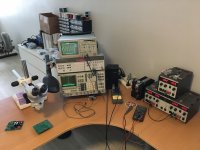
From the left:
Nikon SMZ-645 stereo microscope on boom stand (eBay)
Tektronix TDS-340A 100MHz 500Msps digital CRO (rescued from junk bin and repaired)
HP3325B 21MHz synthesised function generator (rescued from junk bin and repaired)
HP3585B 40MHz spectrum analyser (rescued from junk bin and repaired)
Frex LT AN-67 1KHz super-low-distortion oscillator (tucked under spec-an)
Metcal MX-500P HF soldering iron (eBay)
8Ω dummy load (home-brew)
+/-40V 160W power supply (home-brew)
Thurlby PL154 15V, 4A lab supply (eBay)
Twin Thurlby PL320 30V, 2A lab supplies (eBay)
Fluke 87 multimeter (eBay)
I'm on the hunt for a decent LCR meter now.

A recent look at my bench - years in the making
Hi all.
So this is what I use with a permanent location. There is some other equipment that only comes out to play when needed. Normally light stuff as you can imagine.
Things have changed a little more, so I'll have to clean up the bench and take some more current pics.
One thing some of you may have noticed is that the equipment is housed in home-built 19" racks. These sit on a table in the rear so that bench vibrations don't upset the equipment as much. After all the benches I've had in the past, this seems to be the easiest to live with, and I even moved it once in the basement already! The bench top sits on drawer units in front, legs in the back. The table for the equipment is also homemade. Couldn't afford to do this any other way, plus the help from great friends of course!
I have had to repair almost every piece of equipment you see here. At least it's all solid after repairs. Some is calibrated, and the other equipment calibrated to that. Not perfect, but if you look up the cost of certifications you'll understand right away.
-Chris
Hi all.
So this is what I use with a permanent location. There is some other equipment that only comes out to play when needed. Normally light stuff as you can imagine.
Things have changed a little more, so I'll have to clean up the bench and take some more current pics.
One thing some of you may have noticed is that the equipment is housed in home-built 19" racks. These sit on a table in the rear so that bench vibrations don't upset the equipment as much. After all the benches I've had in the past, this seems to be the easiest to live with, and I even moved it once in the basement already! The bench top sits on drawer units in front, legs in the back. The table for the equipment is also homemade. Couldn't afford to do this any other way, plus the help from great friends of course!
I have had to repair almost every piece of equipment you see here. At least it's all solid after repairs. Some is calibrated, and the other equipment calibrated to that. Not perfect, but if you look up the cost of certifications you'll understand right away.
-Chris
Attachments
We'll have to start the 3585 appreciation society. You have rather a staggering amount of test gear on your bench. I presume it's open at the back so you can plug stuff in there as well? When I've racked stuff up at work I've found I end up with as many blank panels with bulkhead connectors as I do gear, just so I can plug stuff in.
Hi Suzy,
It is, but I use it all. I work on repairs, design circuits and do prototypes and also train myself. One thing I hate about building new stuff is that it makes an unbelievavble mess of the bench!
The rear is open so I can get to the various jacks easily. I have a GPS disciplined 10 MHz frequency reference that is connected to every instrument that will accept an external clock.
I have some panels coming for connections. I'm going to have to be creative in order to bring out the connections I want. It's a real pain either way - as you know.
-Chris
It is, but I use it all. I work on repairs, design circuits and do prototypes and also train myself. One thing I hate about building new stuff is that it makes an unbelievavble mess of the bench!
The rear is open so I can get to the various jacks easily. I have a GPS disciplined 10 MHz frequency reference that is connected to every instrument that will accept an external clock.
I have some panels coming for connections. I'm going to have to be creative in order to bring out the connections I want. It's a real pain either way - as you know.
-Chris
As for the 3585 appreciation society, I agree. Mine is an "A", you have a "B" model. Do you know what the difference is Suzy?
I have another 3585A that has a totally dead CRT. Even the CRT cover was removed by someone to get that extra month of service out of it. There is a company that makes LCD screens as replacements for HP stuff, and one Tektronix instrument. It's colour too! They are in California. Anyway, I find the 3585 so easy to use that I'd like to fix the other one some day and sell the one on my bench. My CRT is in really good shape. The one with the dead CRT was given to me after the owner gave up on finding a replacement.
I even have an old 3580A audio spectrum analyser. I bought it years ago when I was starting to build my bench. It needs work now. It's claim to fame is a 1 Hz wide window. Pretty impressive, but the 3585 is about 3 Hz wide, so that is really impressive too.
-Chris
I have another 3585A that has a totally dead CRT. Even the CRT cover was removed by someone to get that extra month of service out of it. There is a company that makes LCD screens as replacements for HP stuff, and one Tektronix instrument. It's colour too! They are in California. Anyway, I find the 3585 so easy to use that I'd like to fix the other one some day and sell the one on my bench. My CRT is in really good shape. The one with the dead CRT was given to me after the owner gave up on finding a replacement.
I even have an old 3580A audio spectrum analyser. I bought it years ago when I was starting to build my bench. It needs work now. It's claim to fame is a 1 Hz wide window. Pretty impressive, but the 3585 is about 3 Hz wide, so that is really impressive too.
-Chris
You're going to hate me for saying this, but I ratted parts from a 3585A (multiplier diodes for the EHT circuit) to get my 3585B working, then ripped the front panel off for a colleague's kids cubby house, and sent the rest to landfill. Including the tube.
I don't recall many differences at all - the A model I ratted was DOA, as was my B model. I concentrated on getting the B one working for no better reason than that it was newer.
Incidentally have you checked the EHT? Mine exhibited symptoms of a dead tube (even had a dark tinge) but when I fixed the supply it came up perfectly.
I do love the 3Hz filters on my 3585, but my god it's slow when I use them.
I'm keen on getting my home workspace up to scratch at the moment as I'm in the throes of moving to a new facility (running the place, which is cool) but as a consequence will totally lose my labs. So no more vapour phase reflow, no more microscopes, no more lathe, no more mill, no more sheet metal gear. On a positive note I've got a pair of masers now rather than just the one, plus a couple of klystrons, and rather a lot of S and K band gear, which I'm sure will be a hoot. But it's all about running the place and not about designing/building.
I don't recall many differences at all - the A model I ratted was DOA, as was my B model. I concentrated on getting the B one working for no better reason than that it was newer.
Incidentally have you checked the EHT? Mine exhibited symptoms of a dead tube (even had a dark tinge) but when I fixed the supply it came up perfectly.
I do love the 3Hz filters on my 3585, but my god it's slow when I use them.
I'm keen on getting my home workspace up to scratch at the moment as I'm in the throes of moving to a new facility (running the place, which is cool) but as a consequence will totally lose my labs. So no more vapour phase reflow, no more microscopes, no more lathe, no more mill, no more sheet metal gear. On a positive note I've got a pair of masers now rather than just the one, plus a couple of klystrons, and rather a lot of S and K band gear, which I'm sure will be a hoot. But it's all about running the place and not about designing/building.
And here's the shambles at the other end of my work desk. It's mostly about my PC - an iMac with an extra 27" display. My old mac mini has found a new life propping up the second display. Much of my working life has been doing CAD work, and I've always been desperate for more screen real estate. I also need more Raaco drawers.
Attachments
Hi Suzy,
My reply was lost, darn it!
I would have done the same thing you did to save the 3585B - for the same reason. The only change would have been that I would have kept the 3585A to fix later. The one thing that really hurts is the CRT being tossed. Mind you, I haven't checked the other 3585A with the "dead" CRT. I just took the owner's word that it was dead and tried it. Confirmed that you could get an image on the CRT no matter what you did.
I will check the EHT the next time I'm into it. Thank you very much for the suggestion as I didn't think to check everything for myself.
Once you have things running at work, you'll be designing at home. Just save as much gear from hitting the garbage as you can. There are lot's of folks out there that can really use that stuff. It hurts t even hear about equipment being thrown out, and that happens daily.
-Chris
My reply was lost, darn it!
I would have done the same thing you did to save the 3585B - for the same reason. The only change would have been that I would have kept the 3585A to fix later. The one thing that really hurts is the CRT being tossed. Mind you, I haven't checked the other 3585A with the "dead" CRT. I just took the owner's word that it was dead and tried it. Confirmed that you could get an image on the CRT no matter what you did.
I will check the EHT the next time I'm into it. Thank you very much for the suggestion as I didn't think to check everything for myself.
Once you have things running at work, you'll be designing at home. Just save as much gear from hitting the garbage as you can. There are lot's of folks out there that can really use that stuff. It hurts t even hear about equipment being thrown out, and that happens daily.
-Chris
My small cellar cell is rather rudimentary, space needs to be used to maximum. Hanging plastic bags with curtain clips onto wire ropes allows inserting new component values/screw sizes in proper order at any time. Plus dirt cheap too 🙂
Attachments
The one thing that really hurts is the CRT being tossed.
There's a fella on EBay who sells an LCD replacement screen which works for the HP3577. I would imagine that the 3585A/B was an even more popular instrument warranting an LCD replacement.
- Home
- Design & Build
- Equipment & Tools
- What's on your workbench???
